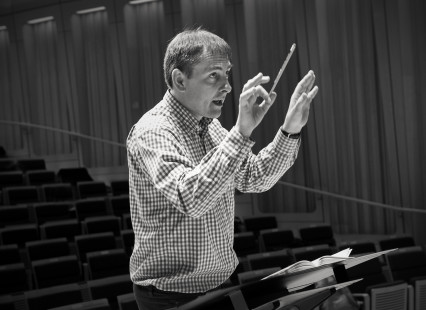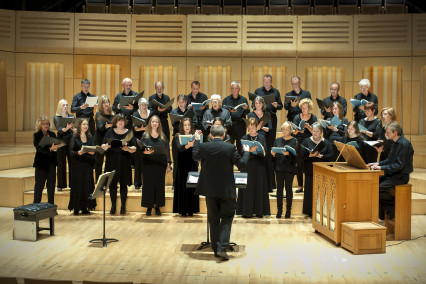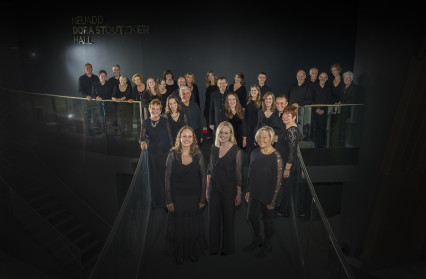Dora Stoutzker Hall, Royal Welsh College of Music and Drama, Cardiff, April 23, 2016
Cantemus Chamber Choir, Réjouissance (leader, Simon Jones)
Elin Manahan Thomas (soprano), Martha McLorinan (mezzo), Guy Cutting (tenor), Julian Empett (baritone)
Conductor, Huw Williams
Mozart Mass in C minor K.427
Mozart: Requiem Mass K.626
Not often in the concert hall do we get the chance to hear side-by-side performances of Mozart’s two great settings of the Mass. Any choir proposing the arrangement must be certain of being able to express the devotional differences between them, the earlier Mass in C minor with its brighter and more complex textures contrasting with ones more suited to the long-breathed and much more subdued atmosphere of the posthumous Requiem. The platform on this occasion looked just right: a numerically-ideal choir with a proper constituency of male and female voices; a period ensemble with no more and no fewer musicians than were required; and a quartet of soloists primed to set each other alight.

And so it turned out. The approach of conductor Huw Williams all evening was to insist on no holding back, and that meant not just in the full-on choral writing and ever more elaborate conjunctions of soloists in the C minor but also their darker counterparts in the Requiem. The orchestra was in sharp, sprightly form. In the RWCMD’s relatively small performing space, the whole team sounded concentrated and of a piece. It would have been interesting, for those who didn’t twig, to learn from the programme note which performing versions of these two uncompleted works – not finished by the composer, that is – were being sung; to present them almost as though scholars had never made careers out of deciding what we are or should be hearing detracts from the interest they arouse when placed in their historical context.
Few other singers can unveil a devotional work as aerially as Elin Manahan Thomas did in the opening Kyrie of the C minor and she sustained her empyrean glow throughout the evening, not as something remote from the other three soloists but as a counter to their lower-register animation. The duet with Martha McLorinan in the Domine Deus was the first example of that after the mezzo had fired proceedings with non-showy coloratura in the Laudamus te, the point at which Réjouissance also began to assert an authority they would maintain in both works. The choir was also smartly out of the gate, and after the range and intensity of the landmark Qui Tollis for split voices, processed to despatch neatly-tailored performances of the Cum Sancto Spiritu, the Credo and – in another double chorus – the Sanctus, though in expressing their get-up-and-go they sometimes sounded over-eager. Particularly lovely were the combination of Manahan Thomas, McLorinan and the tenor Guy Cutting in the Quoniam.

The musicologist H. C. Robbins ‘Robbie’ Landon (who once did an honorary stint at Cardiff University and lived at the time in Chepstow) was himself no slouch when it came to tinkering with the uncompleted score of the Requiem, bringing forward the name of Joseph Eybler as the Mozart pupil whose ‘filling-in’ of some parts of it made more sense as Mozartian re-constructions than did those of the once much-lauded Franz Xaver Süssmayr in other places. He concluded typically that whoever of the pupils did what, in addition to Süssmayr’s composition of the Sanctus, Benedictus and Agnus Dei, the music everyone knows and sings is to all intents and purposes a Mozart composition. Hack work some of it may be, but it’s Mozart-inspired hack work, and that makes a difference.
Despite the size of the choir and the ‘period’ feel of the orchestra (including an 18th-century solo trombone, or its copied equivalent, but a fortepiano that proved inaudible on the crowded stage), this was less an attempt at re-creating a contemporary sound as marshalling forces to get at the heart of the work, beside which nitpicking scholarship might be regarded as interesting but not vitally important. It was obvious from the start that we were in a different place from the one the C minor inhabited. The chorus was no less energetic and Williams no less concerned that every voice should be heard. It was interesting to speculate which was the more influential: choir on orchestra or orchestra on choir. But it was the darker though ultimately uplifting mood that prevailed, incorporating a Baroque influence (the Kyrie), the quasi-operatic nod (Dies Irae) and the quirky interpolation (Tuba mirum), whose spirit was adhered to, the last with baritone Julian Empett responding to his second call of the night with commendable depth and restraint. It all ended memorably, and that applied to the whole concert. We may not encounter the pairing of these two works often; but even less frequently do we come across a choir of this sort willing to take them on with one voice.



 Enjoyed this article? Support our writers directly by buying them a coffee and clicking this link.
Enjoyed this article? Support our writers directly by buying them a coffee and clicking this link.







